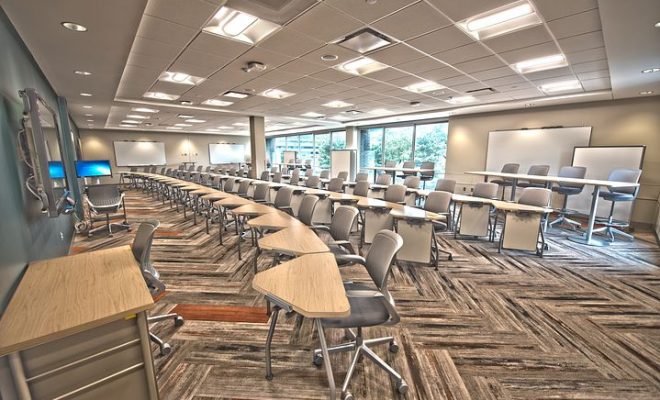Explainer: what is the hybrid classroom and is it the future of education?

This article was written by Natalia Kucirkova.
When artists blend styles into a Latin reggae or manufacturers mix tablets with laptops to create a phablet, the idea is to create a superior product or a new artistic experience. Often seen in art and business, hybrid solutions are gaining increased attention in education. In the classroom, the blend of traditional and new teaching methods, and the mix of online and face-to-face learning – known as the “hybrid classroom” – is posing profound questions about the lessons of the future.
Yet much of the focus so far on the future of classrooms has been on technologies that disrupt rather than merge new and traditional teaching methods. Central to this thinking are the models of “personalised learning” and the “flipped classrooms”.
Personalised learning focuses on each individual’s active contribution to the learning process. The idea dates back to the 19th century and American educator Helen Parkhurst’s Dalton Plan, but there is no doubt that portable personal technologies such as tablets and smartphones can revolutionise the way personalised learning occurs in schools today. Several technology companies, such as Apple, actively advocate for personalised learning to change, not just facilitate, traditional ways of teaching.
Flip it rather than merge it
One model inspired by personalised learning is the popular “flipped classroom” model. The idea originated with two US teachers in 2007 and since then, has spread in many classrooms in the US, UK and Australia.
While definitions vary, the essential idea is that the traditional classroom is flipped on its head. The original idea was to teach students new content at home – predominantly online by watching video lectures – and do homework in class. Since then, The Khan Academy, a non-profit operating according to the flipped classroom model, has popularised the concept, with more than 235m lessons viewed online.
The effects of the model on children’s learning and skills are gradually being analysed. In the UK, Nesta and the National Foundation for Educational Research are currently working to explore the impact of such reverse teaching models in several secondary school maths departments across the country.
Research funded by the Education Endowment Foundation is investigating a model of flipped learning with Shirelands Academy in the West Midlands. Meanwhile, the US government has invested $3m to test the effectiveness of Khan Academy.
Proponents of the flipped learning model suggest that it can maximise the time that teachers have available for each student in the classroom and enable teachers to act more as guides rather than instructors.
Critics argue that the flipped classroom is merely the first step towards a change. To enable all students to benefit from flipped learning, there needs to be more attention paid to students who come from educational backgrounds where access and use of technology at home is difficult. This could put up barriers where some, more well-off students with devices at home, are able to benefit more than others. Some teachers have set out why they’re not going to be rushing to “flip” their classrooms because of this and other reasons.
While the jury is still out, what the flipped classroom and personalised learning models highlight is a strong turn towards classrooms centred around technology. This can often translate into a debate about whether we need teachers in classroom at all.
Some experiments from developing countries show that children can learn without the need for teachers. But while this may work in some circumstances, most current research clearly states that the role of teachers is fundamental and that their beliefs about the way they teach are central to the effective integration of technology into the classroom. The principal task before us is therefore to refocus the debate to find a hybrid model which combines powerful technology with powerful teaching.
Impact of the hybrid classroom

It ain’t easy being a zonkey. Leogirly4life, CC BY
For hybridisation to work in education, we need to begin to ask more ambitious questions about what we lose and gain by combining old with new – and the joint impact for different groups of children, for different subjects and different contexts. So far, we know little about these combinations.
In evaluating hybrid learning models, we also mustn’t lose sight of the fact that hybrid models produce hybridised outcomes. Last year’s results from a comparative study by the Hybrid Learning Institute – which aims to balance digital and traditional instruction – found that students in nine out of ten schools using hybrid learning had higher academic performance on standardised tests compared to traditional classrooms.
This is encouraging, but tells us little about the added value of the combination, and what extra skills the students learnt in the process. As the coalition Partnership for 21st-Century Skills advocates, 21st-century classrooms need to support new soft skills such as communication, team work and time management, as well as traditional skills in core subject areas.
Hybrids are, by definition, complex – and it’s clear we can’t reinvigorate children’s education overnight. Technology can jump-start the process but we cannot leapfrog over traditional infrastructure models in schools. The future of our classrooms is bright if we can carefully blend innovation with sound principles of education, rather than let one replace the other.
![]()
Natalia Kucirkova, Lecturer in Developmental Psychology, The Open University
This article was originally published on The Conversation. Read the original article.





